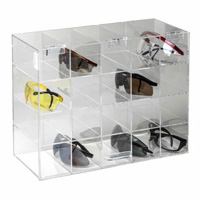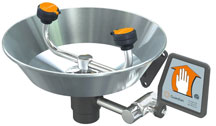| The Home page of ILPI's Safety Data Sheet (SDS) Resource, the leader in SDS information since 1995! | |
| The history and philosophy behind this resource. | |
| A curated collection of books and reference materials concerning Safety Data Sheets and closely related topics. | |
| Paste your plain text SDS into the SDS-Demystifier, and it will be converted into a hypertext-enriched document with links to detailed explanations of each key term. | |
| An extensive list of frequently asked questions about Safety Data Sheets including regulations, content, compliance, and more. | |
| A humorous take on Safety Data Sheet jargon. Fill in the blanks on our entry form to generate a personalized Unsafety Data Sheet to share with your coworkers. | |
| Since 1995, we've maintained this massive curated list of the best places to find Safety Data Sheets on the Internet. | |
| Way more than a glossary, this hypertext-enhanced resource covers hundreds of SDS-related terms and expert knowledge. Each entry includes both the SDS relevance and links to additional authoritative resources. | |
| Archived results of Safety Data Sheet related polls taken by some of our millions of site visitors | |
| You are here! The OSHA regulations behind SDS regulations, including the inspection guidelines and over 400 official interpretations letters under the Hazard Communication Standard | |
| Commercial suppliers of SDS authoring and management software as well as cloud compliance services. | |
| Commercial companies that will create SDS's for your specific needs as well as SDS translation companies. |

Safety signs, banners, and scoreboards? Get yours at Safety Emporium!
| Title: 01/09/2012 - Dental office employers with one or more employees must comply with the OSH Act. | |
| Record Type: Interpretation | Standard Number: 1975.4; 1910.1200; 1910.1030; 1910.132 |
ILPI Notes: This interpretation is based on and references the HCS 1994 which is now obsolete. While some parts have been deleted or changed, the conclusions of this interpretation appear consistent with the current regulation.
January 9, 2012
David Kennedy, DDS
1068 Alexandria Drive
San Diego, CA 92107

Medical offices can make their PPE "readily accessible" per OSHA with these attractive safety dispensers such as this one from Safety Emporium.
Dear Dr. Kennedy:
Thank you for your August 23, 2011, letter to the Occupational Safety and Health Administration (OSHA). Your letter has been referred to the Directorate of Enforcement Programs for an answer on the applicability of OSHA standards to dental offices. This letter constitutes OSHA's interpretation only of the requirements herein, and may not be applicable to any questions not delineated within your original correspondence. Your paraphrased question and our response is below.
Question: Scientific literature shows that dentists and dental personnel are exposed to mercury under normal working conditions and recommends that dental offices take steps to prevent employee exposure. However, dental offices are generally not in compliance with OSHA standards concerning mercury exposure and hazard communication, and dental schools do not teach these OSHA requirements. Why are dental offices not required to be compliant with OSHA's standards to protect employees?
Response. Regardless of a dentist's education, training or licensing, if he or she has one or more employees, then he or she must comply with the Occupational Safety and Health Act of 1970, 29 U.S.C. 651 et seq. ("Act"). The Act requires each employer: (1) to furnish each of his employees employment and a place of employment which are free from recognized hazards that are causing or are likely to cause death or serious physical harm to his employees; and (2) to comply with the occupational safety and health standards promulgated under this Act. [29 U.S.C. 654(a)]
Upon review of recent scientific literature concerning mercury exposure in dental offices, OSHA agrees that dental employers must take steps to prevent hazardous exposures to mercury. OSHA's Hazard Communication standard, Regulation citation: 29 CFR 1910.1200 [in context: HCS 1994 | current regulation: HCS 2012], would apply with regard to situations where employees are exposed to mercury and other hazardous chemicals in dental offices. Mercury is a hazardous chemical because it meets one of the criteria in 29 CFR 1910.1200(d) [in context: HCS 1994 | current regulation: HCS 2012] , i.e., listing in Table Z-2 of 29 CFR 1910.1000, OSHA's Air Contaminants standard. See 29 CFR 1910.1200(c) [in context: HCS 1994 | current regulation: HCS 2012] (definitions of "hazardous chemical" and "health hazard"); 29 CFR 1910.1200(d)(3)(i) [in context: HCS 1994 | current regulation: HCS 2012] (chemicals listed in 1910.1000 regarded as hazardous). The Hazard Communication standard requires, among other things, that employees be trained on the hazards of chemicals to which they are exposed and the measures employees can take to protect themselves from these hazards. 29 CFR 1910.1200(h)(3) [in context: HCS 1994 | current regulation: HCS 2012]. The standard at 29 CFR 1910.1000 prohibits employees' exposure above the applicable exposure limit for any listed air contaminant and requires employers to control exposures through the use of feasible engineering or administrative controls. If such controls are not feasible to achieve full compliance, personal protective equipment or any other protective measures must be used to keep the exposure of employees within the limit.
OSHA has conducted inspections at dental offices and will continue to conduct these inspections as warranted. Citations from recent inspections at dental offices have recorded violations of the Hazard Communication standard, as well as several other OSHA standards, including 29 CFR 1910.1030, Bloodborne Pathogens; 29 CFR 1910.132, General Requirements (personal protective equipment); 29 CFR 1910.133, Eye and Face Protection; and 29 CFR 1910.303, General (electrical).
In an effort to assist dental offices in complying with OSHA requirements, the Agency published in 2004 a pamphlet entitled
Medical and Dental Offices: A Guide to Compliance with OSHA Standards. In the section on the Hazard Communication standard, mercury is mentioned as one of the hazardous chemicals
to which employees in dental offices may be exposed. Please refer to the copy enclosed for your information. This document includes basic information on standards that are applicable to your industry. However, it does not include a complete list of the OSHA standards; the dental employer must evaluate each workplace to determine all applicable standards. Further information about OSHA standards can be found on our website at www.osha.gov. Additional information on safety and health hazards in the dental industry can be found on OSHA's website, on a safety and health topics page for dental personnel, at https://www.osha.gov/SLTC/dentistry/index.html https://www.osha.gov/dentistry. Specific information about mercury can be found at "https://www.osha.gov/SLTC/mercury/index.html https://www.osha.gov/mercury.
As you aware, the State of California operates its own occupational safety and health program under a plan approved and monitored by federal OSHA, (Cal/OSHA). Employers in the State of California must comply with state occupational safety and health requirements. As a condition of plan approval, state plans are required to adopt and enforce occupational safety and health standards that are at least as effective as those promulgated by federal OSHA, and to interpret these standards as effectively as federal OSHA does its own standards. Cal/OSHA has its own PEL for mercury, metallic and inorganic compounds as elemental mercury (Hg). If you would like further information regarding California's occupational safety and health requirements as they relate to dental offices, you may contact California's Division of Occupational Safety and Health at the following address:
Division of Occupational Safety and Health
Cal/OSHA
1515 Clay Street, Suite 1901
Oakland, CA 94612
Ph: (510) 286-7000
Fax: (510) 286-7037
Website: www.dir.ca.gov/DOSH
Thank you for your interest in occupational safety and health. We hope you find this information helpful. OSHA requirements are set by statute, standards and regulations. Our interpretation letters explain these requirements and how they apply to particular circumstances, but they cannot create additional employer obligations. This letter constitutes OSHA's interpretation of the requirements discussed. Note that our enforcement guidance may be affected by changes to OSHA rules. Also, from time to time we update our guidance in response to new information. To keep apprised of such developments, you can consult OSHA's website at www.osha.gov. If you have any further questions, please feel free to contact the Office of Health Enforcement at (202) 693-2190.
Sincerely,
Thomas Galassi, Director
Directorate of Enforcement Programs
[Enclosure]
The original official public domain version of this document is available from OSHA at https://www.osha.gov/laws-regs/standardinterpretations/2012-01-09-0.
